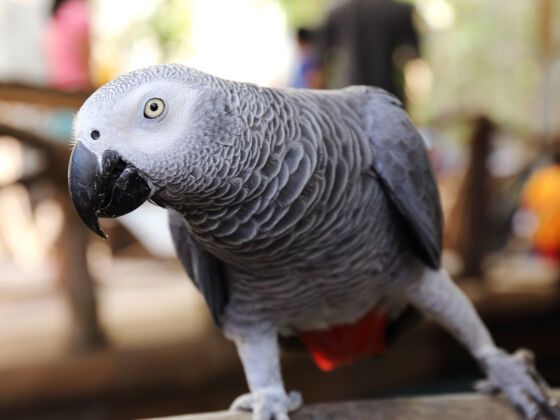ANY MEMBER OF the parrot (or parakeet) family is your best bet but before you rush out to your nearest pet store, you’ll need both time and money to spare; feathered friends require a huge amount of commitment and investment. Costing anywhere between $20 (a baby budgie) to $5,000 (a mature macaw), birds have a much longer lifespan than the average pet and some larger species will even outlive their owners.


They can also be loud and messy creatures and like a small child, will crave attention.
The only way to be 100% sure that you are getting a bird that will talk is to buy a bird that already talks. However, mature animals may have existing behavioural problems (like an unruly adolescent) and this isn’t a good start for the novice. It’s probably best to look for a hand-fed baby so you can teach it yourself from scratch; this will not only be a great way to bond, but also improve chances that he or she will speak.
As there are several hundred different species of parrot, it’s important you do some research to find out which one suits your personality and lifestyle. Although bigger birds make impressive pets, they can be more stubborn and moody and are not the best choice for a starter bird.
Once you’ve made a decision, look for a reputable breeder or supplier. Parrots are delicate creatures– even a healthy looking specimen might be carrying some sort of disease. Buy from someone you can trust.
Key species that have the ability to ‘speak’ include:
African Greys:
Known for their extensive vocabulary and cognitive skills, these are highly esteemed among the parrot family.
Amazons:
Have a good reputation thanks to their outstanding talking ability and make a reliable pet.
Budgies:
Small, affectionate and attractive, budgies are a great budget buy. With an average lifespan of 8 – 10 years, they may take a little more effort to train but can become incredibly proficient talkers.
Cockatiels:
Originally from Australia, cockatiels are the smallest member of the Cockatoo family. Known for their excellent whistling and imitation skills, with love and attention, they’ll take on an extensive vocabulary.
Conures:
What Blackbeard would’ve had, these come in an array of colours and are the joker of the pack. They are prone to the occasional screeching outburst and can nip but they love to play and cuddle and can make very rewarding pets.
Macaws:
One for the more experienced owner, Macaws have an excellent talking ability and form a strong bond with humans. They do require constant training to keep them under control and stop them from being excessively loud.
Quaker Parrots:
Their dull exterior hides a fantastic personality. Quakers can be impressive talkers and are capable of using words within 6 months. Their reasonable price and life expectancy makes them an excellent choice.
Ringneck Parrots:
Ringnecks are also a good option as they speak clearly and have attractive plumage.
Now comes the tricky bit: training.
Using the bird’s name or a few easy words to start (“hello”, “goodbye” and “peek-a-boo” are popular though rather unoriginal), speak enthusiastically in a happy and positive tone. Watch the parrot’s reaction and whichever word gets the most response, make that your first training word.
Birds learn to mimic through repetition so repeat the word as often as possible. Bear in mind that some birds can take months or even years to say their first word.
If you don’t think you are getting anywhere, try whistling as many birds find this easier than speech. Also, listen out for your bird mimicking the environmental sounds around your home, such as the telephone, doorbell, and alarm.
Confidence is also important in encouraging the bird to speak; if it feels unsafe, it won’t want to attract attention. Many parrots are shy and will prefer to talk when humans aren’t present so try moving the cage to a more protected area. On the other hand, another human often stimulates speech as the bird will compete for the owner’s attention.
If the bird is making unpleasant sounds or lots of noise, it may be unhappy. Like a child, pets need a good diet, a clean and safe place to live, toys to play with, and human interaction. Improve the environment and spend time training the bird to use more appropriate sounds.
Once the bird has mastered imitative speech, it’s time to move on to responsive speech, where you teach the bird to answer questions. While this takes a lot of practice and patience, the results are obviously pretty cool. But be warned: this can take years.
Whatever the clerk in the pet store tells you, there is NO guarantee your bird will ever talk. Birds need huge amounts of love, patience, and training. Even if yours never speaks a word (and some never will), don’t be disappointed. With all that time spent together, you’ll have made an intelligent and interesting (albeit silent) companion. At least they’ll agree with everything you say.
Community Connection:
Traveling with your pet? Check out our 10 tips for traveling with pets here.